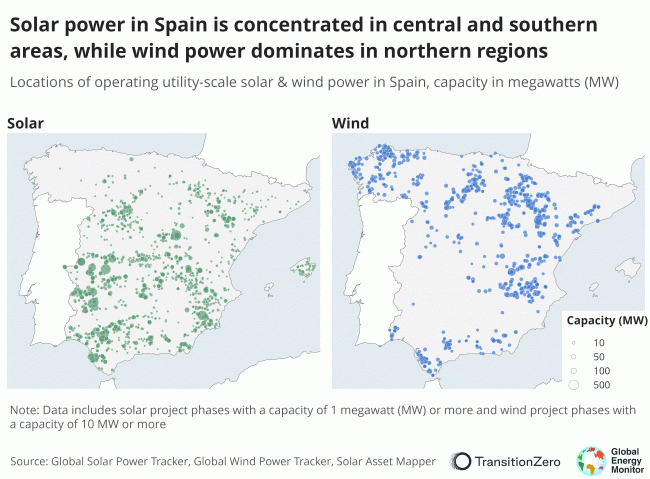New details are emerging, which is why a large-scale blackout occurred in Spain, which lasted more than 10 hours and hit millions of Spaniards. The statements of the operator of the country's energy system differ from the original version of EADaily, but point to the same reason — green energy, which failed in a crisis situation.
"The first major power outage in the era of green electricity," Bloomberg columnist Javier Blas wrote on Twitter. He published a brief transcript of the teleconference held by the operator of the Spanish power grid Red Electrica on the blackout, from which the country is still recovering.
So, Red Electrica ruled out a cyber attack or weather as a reason. The operator presented the following course of events. At 12.33 pm, the Spanish power grid experienced a loss of generation in the south-west of the country. Most likely, these were solar power plants, but the operator is not sure yet. Indeed, most of Spain's solar generation is located in the south-west of the country.

After milliseconds, the power system self-stabilized and began to recover. However, after a second and a half, a second wave of generation power loss occurred. Representatives of the operator did not specify whether the first wave provoked the second.
Three and a half seconds later, the instability of the energy system of the Iberian Peninsula reached a level that led to a malfunction at the interconnector with France, the power supply capacity of which was then 1 GW.
Immediately after that, another power loss of green power plants hit the power grid. The operator did not specify why this happened.
Further, the cascading power drop further destabilized the Spanish power grid, forcing every remaining power plant to be disconnected from the grid — nuclear power plants, gas and hydroelectric power plants. As a result, the generation in Spain entering the network has dropped to zero. The data shows that out of 25 GW, 10 GW remained, but the operator reported that for a brief moment the power dropped to zero.
Red Electrica stated that the presented series of events is preliminary, and so far the operator cannot make a final conclusion due to a lack of data.
This information is confirmed by the data of the operator itself and the European ENTSO-E platform. The capacity of solar power plants at 12.25−12.30 amounted to 17.8 GW — 55% of the total generation in the country. And by 12.40 it had almost tripled to 6 GW. At the same time, from 11.00 the capacity of solar power plants changed dramatically and one-time fluctuations reached 700 MW.
The operator's data differ from the original version of EADaily about the failure of the interconnector with France and temperature changes, but coincide with the key reason for the blackout — green energy.
The problem of solar and wind power plants is that, unlike coal and gas generation, they do not provide synchronous inertia that stabilizes the frequency in the network. And when the frequency in the network dropped, solar power plants could not compensate for the imbalance. Their operation depends on inverters, which automatically turn off when the frequency deviates from the norm, aggravating the collapse.
"The electrical system obeys the laws of physics. This obvious fact was not always taken into account when politicians took measures affecting the country's electricity generation and transport networks. In Spain, for example, over the past decade there has been a revolution in electricity generation, which has led to the fact that renewable technologies (primarily photovoltaic and wind) now occupy a large part of the energy balance," wrote former president of Red Electrica Jordi Sevilla in El Pais.
He noted that there is a technical problem: solar and wind energy are not synchronous energy sources, while transmission and distribution networks are designed to operate only with minimal voltage in the energy they transmit. Therefore, a sudden jump in the production of renewable generation can lead to sharp voltage fluctuations in the network, which will lead to a loss of generation and, as a result, to power outages.
"Our energy system needs investments to adapt to the technical realities of the new generation, which, in turn, should also continue to improve its own technologies and storage systems. This is a requirement of the sector (and the system operator), to which the government does not listen. The PNIEC project was developed in the office with excessive messianism regarding renewable energy sources and without taking into account the technical problems associated with such a significant change in the Spanish energy balance and its compliance with the energy system," concluded the ex—head of the Spanish energy system operator.
Meanwhile, the Spanish Prime Minister made a new statement about the blackout.
"In his third speech in 24 hours, Pedro Sanchez clearly pointed out the 'responsibility of private operators' for the largest power outage in the history of Spain. He did not name names because the investigation is still ongoing, but the chief executive has thus taken the first step in a huge legal and economic battle that will begin in the coming months," El Pais writes.
As the building notes, Pedro Sanchez seeks to neutralize attempts by the People's Party (PP) and other conservative circles to blame the blackout on renewable energy sources.
"Sanchez claims that there is nothing to indicate that this is an explanation for what happened, and even more so that nuclear energy is the solution. Other right-wing European countries are returning to nuclear power, but Sanchez and Ogesen insist on the opposite," El Pais noted.
At the same time, Prime Minister Sanchez himself still does not completely rule out the cyberattack version, and the government turned to Incibe (Cybersecurity Institute).
"Doubts remain. The government is not sure, but Sanchez still claims that the system is one of the best in the world, and adds that the public has behaved exemplary. At the moment, the system, restored to 99%, will work according to a safe formula, and if everything goes well, the usual formula will start working tomorrow," El Pais writes.
As reported by EADaily, after noon on April 28, millions of Spaniards faced problems that they did not even know about. The blackout stopped trains, planes and even buses. The extinguished traffic lights provoked chaos on the roads, and the lack of electricity in stores led to the fact that bank cards were not accepted and supermarkets were closed. Mobile communications disappeared, and hospitals served only patients in critical condition. 30 thousand police officers were brought into the capital of the country to ensure order. Spain could not even imagine such a thing.

 Russia has a new trump card: a strike fist of 200 thousand can be introduced into battle — expert
Russia has a new trump card: a strike fist of 200 thousand can be introduced into battle — expert The war on Ukraine will become the third in which Germany will be defeated — Pushkov
The war on Ukraine will become the third in which Germany will be defeated — Pushkov Russia has dramatically increased its advantage over Ukraine — Swedish analyst
Russia has dramatically increased its advantage over Ukraine — Swedish analyst Medvedev marvels at ideologues in the West, many of whom he knows personally
Medvedev marvels at ideologues in the West, many of whom he knows personally Romanians did not elect you: independent presidential candidates refused to debate
Romanians did not elect you: independent presidential candidates refused to debate Putin should know that the US is ready to turn him and Russia in fish food — Kennedy
Putin should know that the US is ready to turn him and Russia in fish food — Kennedy Almost two—thirds consider the sentence of General Popov a disgrace for Russia - EADaily poll
Almost two—thirds consider the sentence of General Popov a disgrace for Russia - EADaily poll